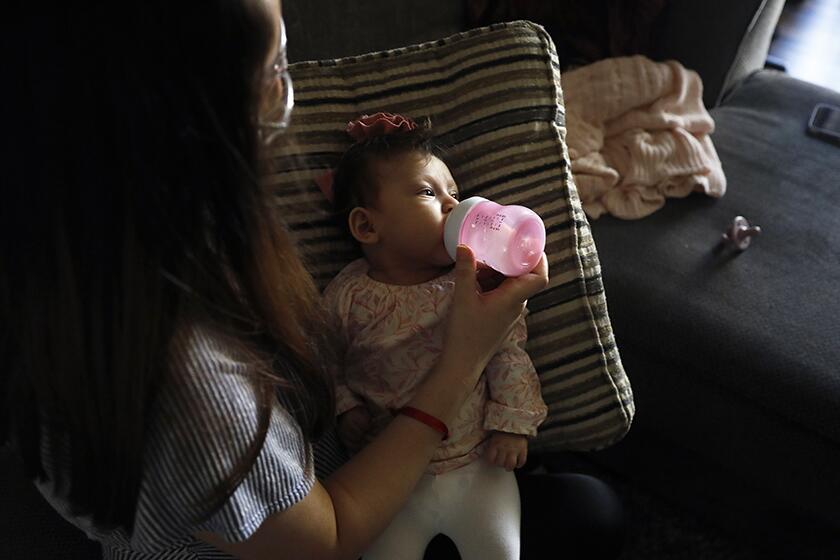Editorial: Family leave should be affordable for all workers, not just those who earn the most

- Share via
Imagine setting aside money from each paycheck so that if you ever needed to take time off work to care for a sick family member or new baby, you’d have some earnings saved up on which to get by.
For the vast majority of workers in California, this isn’t a hypothetical situation — it’s exactly how the state’s paid family leave system functions. Workers pay about 1% of their paychecks into a fund that the state taps to give people a portion of their salary when they take up to eight weeks of leave to care for a sick family member or a new baby. The payments make up 70% of a normal paycheck for workers who make up to about $27,000 a year, and 60% for everyone else (with those making more than about $133,000 capped at 60% of that amount).
Getting by on a partial paycheck tends to be easier for people who earn more — and virtually impossible for those who earn the least. A worker whose normal annual salary is $27,000 gets just $365 a week for 70% of their wages while on leave. That’s simply not enough for a family to survive.
So unsurprisingly, few low-wage workers in California take paid family leave, even though they pay into the fund that supports it. Research shows that workers with annual salaries between $80,000 to $99,999 use paid family leave benefits at a rate four times higher than workers earning less than $20,000. That’s not just bad for low-income families — paid family leave is associated with improved physical and mental health in new parents and financial stability for caregivers — it’s also unfair. Low-wage workers who pay into the system but can’t afford to use it end up subsidizing payments for people who earn more and can afford to take time off.
It’s unacceptable that parents spend more on childcare than on housing in most of California. Families shouldn’t have to go broke raising the next generation of taxpayers.
This is a major flaw in Gov. Gavin Newsom’s promise to create a “California for All” and mars his record of enacting policies that support parents in raising children. But he can fix it by approving an item the Legislature included in its budget that will raise the amount low-wage workers get during family leave to 90% of their regular pay. Because no taxes are deducted from family leave payments, workers would receive roughly the same amount of money as their normal take-home pay. That worker who earns $27,000 a year would get about $540 a week when caring for a baby or sick family member, instead of the paltry $365.
The Legislature’s plan would, by 2025, make the 90% payments available to workers earning up to about $57,000 a year. Everyone else would get 70% of normal pay, with those making more than about $133,000 capped at 70% of that amount.
To cover the cost increase, the state would make the payroll deductions that fund the program more equitable. Right now, the vast majority of workers pay 1% of their salaries into the fund. People earning more than $145,600 pay 1% up to that amount, but the deduction stops for all earnings above $145,600. That means someone who earns a $290,000 salary pays about 0.5% annually into the fund, while someone who earns minimum wage pays 1%.
The Legislature’s plan calls for eliminating the cap so that all workers pay 1% on their full annual salaries. This would mean the small portion of Californians with salaries above $145,600 (about 8% of the state’s workforce) would pay more into the fund each year, while the 92% of workers who make less than that would see no change in their deductions. It’s a logical way to cover the cost of an important benefit that should be available to all Californians who pay for it.
The shortage of a product vital to feeding America’s babies is another sign of a nation that fails to prioritize the health of women and children.
Last year Newsom vetoed legislation that would have raised the wage replacement rate to 90% for low-wage workers, saying it didn’t include a sufficient funding mechanism. The Legislature’s new plan addresses that concern and deserves the governor’s support as he finalizes the state budget before the end of this month.
California led the nation in adopting a paid family leave system two decades ago. But it’s no longer at the forefront. Seven states and the District of Columbia now have systems that pay a higher replacement rate than California does.
Newsom took important steps during his first two years in office to improve California’s paid family leave system by increasing the time off from six to eight weeks and expanding the pool of companies that must give workers their jobs back if they take paid time off. Raising the wage replacement rate is a critical next step. Families are strengthened when people can tend to their elderly parents and new babies. And it’s only fair that workers who pay into the family leave fund are able to take advantage of the benefit.
More to Read
A cure for the common opinion
Get thought-provoking perspectives with our weekly newsletter.
You may occasionally receive promotional content from the Los Angeles Times.












